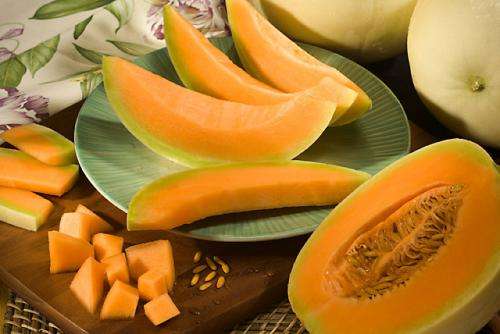Beta-carotene bioavailability of orange-fleshed honeydew

Eating fruits and vegetables is not often thought of as a "treatment." But according to researchers, there are more than 100 million people worldwide who have vitamin A deficiency, and for some of them, consuming fruits and vegetables is the most available treatment. That's because people in many parts of the world do not have access to vitamin supplements. Select fruits and vegetables contain carotenoids such as beta-carotene, also known as "provitamin A." Beta-carotene is the most potent precursor of vitamin A for humans (meaning the body breaks down beta-carotene into vitamin A).
Two excellent sources of beta-carotene are cantaloupe and the orange-fleshed honeydew melon, which is a cross between cantaloupe and green-fleshed honeydew. The orange-fleshed honeydew melon is sweeter and stores longer than the typical cantaloupe melon.
Little is known about the bioaccessibility and bioavailability of the orange-fleshed melon's carotenoids. Before a consumer can make use of a fruit's nutrients, the nutrients must first be released from the fruit tissues—becoming "bioaccessible"—and then they can be absorbed into the circulation—becoming "bioavailable."
To learn more, Agricultural Research Service plant physiologist Gene Lester and colleagues measured the beta-carotene concentrations in orange-fleshed honeydew and cantaloupe melons grown under the same greenhouse conditions.
The team found that orange-fleshed honeydew had significantly higher beta-carotene concentrations than cantaloupe, but the two melon types had similar beta-carotene bioaccessibilities. This means that both melons appear to be comparable sources of dietary provitamin A for humans, on par with carrots, which are known to be a major source of provitamin A.
In the laboratory, the researchers also tested the bioavailability of beta-carotene from orange-fleshed honeydew melon tissue. Plants store beta-carotene in chromoplasts, and beta-carotene bioavailability is affected by chromoplast structure in plant tissues, such as fruit flesh. Chromoplasts in fruits and vegetables come in different types; globular types provide the best beta-carotene bioavailability, while crystalline types provide less. The researchers found that the chromoplasts in melons are globular—the higher beta-carotene bioavailability type—whereas chromoplasts in carrots, for example, are crystalline.
The team also checked for the presence of apocarotenoids in orange-fleshed melon and cantaloupe. This is significant because apocarotenoids are metabolized directly into vitamin A.
"Previously, we did not know apocarotenoids were in orange-fleshed melons," says Lester. After the researchers first noticed the presence of additional peaks indicating compounds not seen before when testing orange-fleshed melons, they used more sophisticated instrumentation to show that these compounds were apocarotenoids.
Lester's team detected and measured levels of the apocarotenoids beta-apo-13-carotenone, beta-apo-14-carotenal, beta-apo-12-carotenal, beta-apo-10-carotenal, and beta-apo-8-carotenal in the orange-fleshed melons.
More information: "Carotene and Novel Apocarotenoid Concentrations in Orange-Fleshed Cucumis melo Melons: Determinations of β-Carotene Bioaccessibility and Bioavailability." Matthew K. Fleshman, Gene E. Lester, Ken M. Riedl, Rachel E. Kopec, Sureshbabu Narayanasamy, Robert W. Curley, Jr., Steven J. Schwartz, and Earl H. Harrison. J. Agric. Food Chem., 2011, 59 (9), pp 4448–4454. Publication Date (Web): March 18, 2011 (Article). DOI: 10.1021/jf200416a
Provided by Agricultural Research Service


















